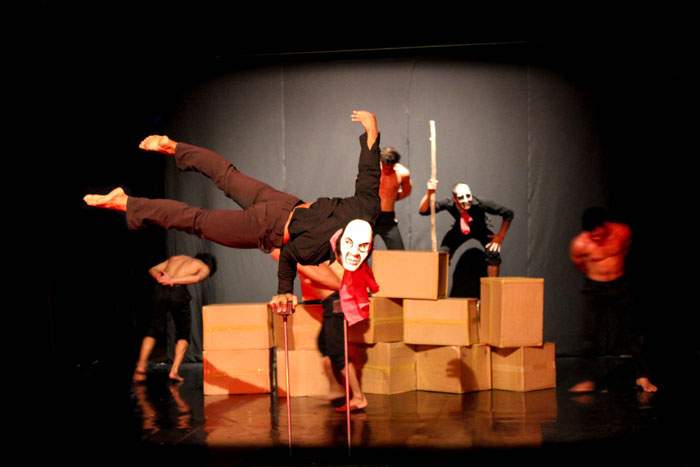
Photo source: https://pharecircus.org/
They call it Cambodian traditional circus, but slapstick clowns and trained poodles, this ain’t.
It’s a steaming hot night in Siem Reap, the tourist town built on the doorstep of one of the world’s great heritage sites: Angkor. Visitors from across the globe fill the neon-lit bars and restaurants on Pub Street, where vendors hawk everything from “Fear Factor” fried scorpions on a stick to toe-tickling foot massages delivered by nibbling aquarium fish. There are only two kinds of people in Siem Reap: those who are there to see the temple ruins and those who are there to extract money from the first group. And who can blame them? This is a poor area in a poor country. Foreigners throw away big money on lodging, food, transport, and fun. Every local desperately needs a piece of that largesse and most work extremely hard to earn it.
In a dusty lot on the dark outskirts of town, far from the hustlers and the massage parlours, stands a tent. Inside, a simple, mostly empty performance space is surrounded by tiers of wooden benches. It’s well organized: young people in bright red t-shirts deal out tickets, hand out bamboo fans to keep the sultry air moving inside the tent, usher patrons to their seats, and sell snacks and merchandise. The place is packed and when everyone is seated, two musicians enter, bow, and take their places. The performance begins.
Sokha is nothing less than a retelling of the horrors that engulfed Cambodia under the Khmer Rouge in the 1970s and the struggles of the people to come to terms with this period when between one and three million Cambodians were executed or died from starvation and disease. The story is based on the experiences of the founders of the Phare Ponleu Selpak School, who lived through that time. The school’s mandate is to provide free education in academics and the arts and to train young artists for professional careers in visual arts, theatre, music, dance, and circus (two of their graduates were recently hired by the Cirque du Soleil). The Phare also strives to create opportunities for local artists and help to revitalize the arts in a country where most artists were targeted for death under the former regime.
The performance is a skillful blending of music, mime, visual art, dance, and acrobatics. With minimal props and basic costumes—a far cry from the elaborate trappings of the Cirque—the artists evoke laughter, tears, amazement, and total engagement from the audience. The story could not be more powerful, and knowing that the performers were all personally affected by the events referenced makes it incredibly moving. The use of masks to dehumanize the persecutors is chilling; you see that the ordinary people were under those masks and participated in the killing.
As the show progresses, we see Cambodia’s slow, courageous steps toward recovery after the end of the Khmer Rouge. Despite the trauma still felt today, the people are acknowledging and healing from their past. They are celebrating the rebirth of the arts through performances such as the Phare.
Near the end of the show, during an emotionally charged scene in which a teacher helps a shattered child to see the healing power of art, the electricity in the tent suddenly went out. The performers froze and did not move for many long minutes while crew scrambled to get the generator restarted. It was like Cambodia herself held her breath through her long darkness, balanced on the knife edge between annihilation and hope. When the lights came on again, the audience cheered and the actors moved forward to the end of the scene and toward a brighter future.
The day after the circus, we went on a nature tour to a manmade wetland in the countryside. It was filled with birds and fisherman poled their dugouts across the serene waters. As we commented on the beauty of the place, our guide said quietly in his broken English: “Built by Khmer Rouge. Three thousand people die.”
More information and tickets for the Phare are available at https://pharecircus.org/. Advance purchase during the high season is recommend; the performance was sold out the night we attended.
Have you seen a local performance during your travels that is a must-see for visitors? Let me know in a comment.



Cambodia — land of a thousand smiles, and a thousand sorrows.
Indeed. Despite the poverty and the hustle to survive, the people were very friendly. I applaud their efforts to acknowledge the past and learn from it.
Rather than comment on any shows I’ve seen, I’d like to comment on the riveting description in your short piece that captured the present hustling of foreign tourists in the city for a bare subsistence with an equal and opposite poignant theatrical experience that unites with the national march to try to escape the fairly recent past. Whereas in Vietnam there is a psychological distance from the horrors of war by naming it “the American War”, the massacre of millions of Cambodians by their fellow citizens has no such luxury.
I wonder if the generator is poised to go out intentionally for performances or if it is a unique event that allowed the audience a grand, hopeful ending?
I shared your blog with writers in my group and their first reaction is: “Well done and let’s pre-book tickets to that theatre when we go in 2018!!” Thank you for sharing this.
You know, I wondered the same thing when the lights went out. But judging by the reactions of the cast and crew, I’d say it was unpremeditated. I hope your group has a grand time in Asia and that you do get to see the Phare.